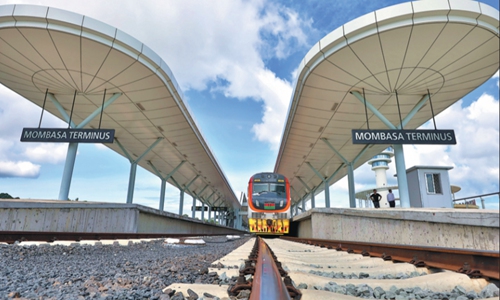
A train rolls in at the Mombasa Terminus of the Mombasa-Nairobi Standard Gauge Railway. Photo: Xinhua
At one point the politicization of Kenya's Standard Gauge Railway, a railway system that connects Kenyan cities, and links Kenya to the neighboring countries, threatened to overshadow the benefits inherent in the China-built mega project.Built by the China Road and Bridge Corporation, this modern railway connects the port city of Mombasa to Kenya's capital Nairobi, reducing travel time from 12 hours to just 4.5 hours.
More importantly, the East African Railway Master Plan provides for the Mombasa-Nairobi Standard Gauge Railway to link such other railways being built within the East African Community which includes Tanzania, Uganda, Rwanda, Democratic Republic of the Congo and South Sudan.
Consequently, political propaganda was beginning to spill over the East African Community derailing progress toward regional connectivity and integration.
Such propaganda was potent enough to interfere with the railway's capacity to accelerate economic growth.
The Standard Gauge Railway lines were designed to facilitate the implementation of the respective country's economic blueprints.
Kenya's China-built railway for instance is in tandem with the Kenya Vision 2030 that seeks to transform the East African country into a newly industrializing, middle-income nation.
Politics and propaganda around Kenya's mega Standard Gauge Railway revolved around the country's capacity to afford such a mega undertaking, the biggest infrastructure project since the country gained independence.
But as soon as these concerns were laid to rest, a narrative emerged that it was only a matter of time before the Chinese took over the Mombasa port.
According to the narrative, Mombasa port had been used as collateral in the Standard Gauge Railway line loan repayment agreement with China.
It is these myths and misconceptions that have shadowed this unprecedented masterpiece and have necessitated constant explanations by the government.
But beyond political assurances from the government that this is a viable and socio-economically transformative venture, or similar assurances from like-minded economists, it is the ordinary people who have put a stamp of approval on the Standard Gauge Railway line.
Indeed it is the experience of ordinary Kenyans travelling on the Madaraka Express operated by the China-built modern railway that has really brought to a halt the politics and propaganda.
The first fare paying passengers travelled on the Standard Gauge Railway line on June 1, 2017.
At that time there were 11 coaches on the Madaraka Express. Nearly one year later, in June 2018, due to rising passenger demand, coaches on the train were increased to 16 for economy class passengers every Friday, Saturday and Sunday.
This demand has not decreased as passenger uptake continues to exceed expectations. Within the first 17 months of the Madaraka Express making that first maiden trip, the train had ferried a staggering two million passengers between Mombasa and Nairobi.
First commercial freight services began on January 1, 2018 and by November of the same year, the Standard Gauge Railway was operating 30 freight trains.
Every morning a train leaves Nairobi and another Mombasa port city, in the afternoon, the same pattern repeats itself. There are therefore four passenger trains every day.
The morning trains are inter-county because they make brief stops along the way to drop off and pick up passengers. Afternoon trains do not stop along the way.
There are nine stations between Mombasa and Nairobi.
The train itself is properly managed and customer satisfaction is a priority. The coaches are reasonably spacious and clean at all times.
This Standard Gauge Railway line snakes through the transportation corridor between Tsavo East National Park and Tsavo West National Park. Along the way, passengers can spot wild animals including elephants, giraffes, zebras and antelopes.
Travelling by road has often been unpredictable. Unforeseeable mishaps such as accidents, vehicle breakdown or inclement weather such as heavy rain could significantly increase travel time. This is not the case with the Madaraka Express which is reliable and punctual.
Due to the trains' popularity, passengers are advised to make their bookings at least one week before date of travel to secure a seat. In 2018 alone, the railway ferried 1,665,627 passengers and 5,039,988 tons of freight.
As the politicization and propaganda around the Standard Gauge Railway dies down, this is bound to instill confidence across the East African Community that this mega project will significantly enhance the free movement of people and goods across this region.
Numbers speak for themselves and have confirmed that this modern infrastructure has delivered all it promised. Others in East Africa keen on reaping similar benefits are well on their way.
Construction of Standard Gauge Railways has begun in both Rwanda and Tanzania, and the government of Uganda has started to demarcate routes through which their modernized railway is set to pass.
The author is a Kenya-based journalist. opinion@globaltimes.com.cn

